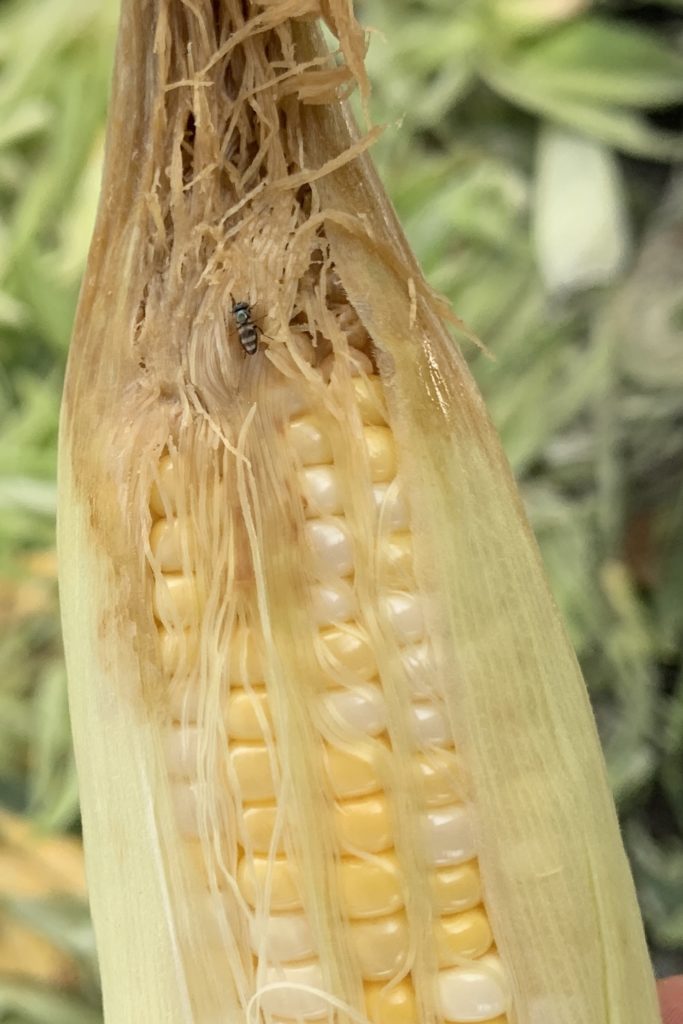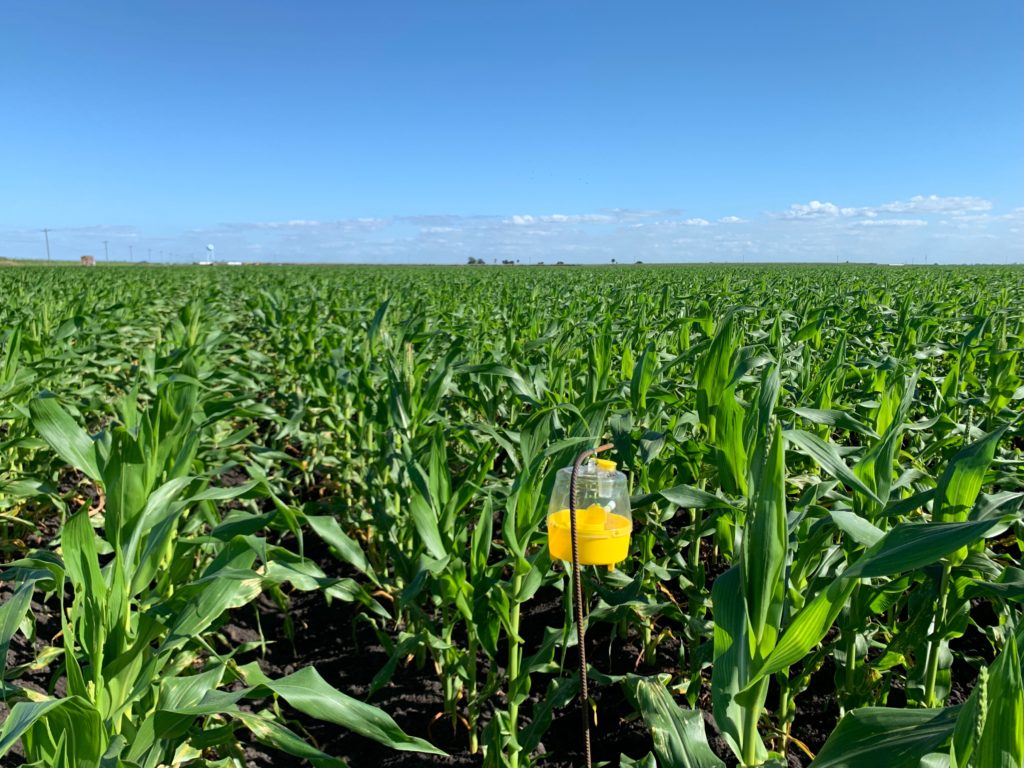By Julien Beuzelin
Fall armyworms and corn silk flies are the main insect pests of sweet corn in Florida. Management relies primarily on insecticides, but the two pests represent different challenges.
Fall armyworm infestations can be devastating if left unmanaged. However, several registered insecticides such as methomyl (Lannate, Nudrin), chlorantraniliprole (Coragen, Vantacor) or spinetoram (Radiant) are very effective at maintaining infestations below damaging levels.
Corn silk flies are more difficult to manage than fall armyworms, with repeated applications of registered insecticides not always providing acceptable control. Thus, numerous research projects led by University of Florida Institute of Food and Agricultural Sciences (UF/IFAS) entomologists have focused on corn silk fly management and ecology.
Corn silk flies are a complex of three species: Euxesta stigmatias, E. eluta and Chaetopsis massyla. Adult flies lay eggs on silks of sweet corn ears, and the emerging maggots feed on silks and developing kernels. Because maggots within ears are protected from exposure to insecticides, management with insecticides targets adults.
Under current production practices, foliar applications of pyrethroids are used. One carbamate (methomyl), one organophosphate (chlorpyrifos) and one spinosyn (spinetoram) have also been used, but to a lesser extent than pyrethroids and often tank-mixed with pyrethroids to improve efficacy. Methomyl has short residual activity, chlorpyrifos applications became illegal after February 2022, and spinetoram is extremely expensive.

PYRETHROID RESISTANCE MANAGEMENT
The development of pyrethroid resistance in corn silk fly populations is a concern because of the heavy dependence on this single class of insecticides. Thus, an insecticide resistance management program was initiated. An “adult vial assay” protocol, which determines adult mortality in small glass vials coated with a pyrethroid, was recently developed to monitor susceptibility levels in field populations.
Eleven populations collected in the Everglades Agricultural Area (EAA) and the Homestead region in 2020 and 2021 were eight to 266 times less susceptible to beta-cyfluthrin than a susceptible laboratory colony. In addition, E. stigmatias populations from commercial fields intensively treated with insecticides were generally less susceptible than populations from untreated experimental fields. Thus, pyrethroid applications in commercial sweet corn fields likely select for less susceptible individuals in a population throughout a growing season. These less susceptible individuals might contribute to the development of resistant populations. Pyrethroid resistance in corn silk fly populations is therefore a serious threat to the production of sweet corn in Florida.
There is a need to develop pyrethroid alternatives allowing the rotation of insecticide modes of action to mitigate the development of insecticide resistance in corn silk fly populations. In laboratory experiments using a spray chamber, 14 potential alternatives to pyrethroids were not effective against E. eluta via topical exposure. However, spinetoram and abamectin (Agri-Mek) still caused measurable lethal effects, consistent with results of previous field experiments. These results confirmed that spinetoram and abamectin, which are both registered for use in sweet corn, should be considered to complement pyrethroid use.
Additional experiments allowed E. eluta adult feeding on insecticides at low concentrations in honey water. Spinetoram and three neonicotinoids — dinotefuran (Venom), clothianidin (Belay) and thiamethoxam (Actara) — caused 70 to 95% mortality 24 hours after ingestion exposure. In addition, cyantraniliprole (Exirel) caused nearly 40% mortality. Thus, these insecticides have potential for use in corn silk fly management if baits attracting adults and promoting ingestion of the insecticides can be developed. Neonicotinoids and cyantraniliprole also would have to be registered for use in sweet corn.
In addition to laboratory studies exploring pyrethroid alternatives, one field experiment evaluated the efficacy of three biological insecticides, alone or in combination with the pyrethroid lambda-cyhalothrin. The biological insecticides were Beauveria bassiana (BoteGHA), Chromobacterium subtsugae (Grandevo) and azadirachtin (Aza-Direct). There was no evidence of a decrease in corn silk fly injury or infestation associated with the biological insecticides alone. In addition, there was no evidence that the biological insecticides might synergize the pyrethroid.
Thus, this field experiment suggests that the three biological insecticides should not be used to improve the management strategy. However, a 40% reduction in the number of corn silk fly adults was observed in plots treated with C. subtsugae and azadirachtin relative to non-treated plots. Although reasons for discrepancies between adult and ear injury observations are unknown, results suggest that C. subtsugae and azadirachtin might have an adverse effect on corn silk fly adults.

WHERE THE FLIES ARE FOUND
Field research has shown that corn silk fly adults are attracted to traps baited with a synthetic lure mimicking cues from protein degradation and host plants. This discovery has provided a new tool that can be used to consistently sample adults in a diversity of locations.
Commercial farms in the EAA were sampled last year during the winter (January–February), spring (March–April) and fall (November–December) to determine adult relative abundance in sweet corn fields and adjacent habitats. In addition, farms in Homestead were sampled during the winter. For each season in the EAA, eight sites including sweet corn, sugarcane, and weedy or woody non-crop habitats were sampled. In Homestead, sweet corn, palm tree nurseries and weedy habitats were sampled.
In each habitat of each site, traps were deployed for two to four weeks. Corn silk flies were present in all habitats during the three seasons. Adults were more abundant in non-crop habitats and sugarcane fields than in sweet corn fields. However, adult numbers were as low in palm tree nurseries as in sweet corn fields in Homestead. Since sugarcane and weedy habitats surrounding sweet corn fields are potential sources of corn silk fly adults, avoiding weedy fields and borders might improve management. Results emphasize the potential importance of habitats other than sweet corn fields in corn silk fly management.
CONCLUSIONS
Recent research shows that corn silk fly pyrethroid resistance management is a priority. Results of ecological studies emphasize the need for frequent insecticide applications to protect sweet corn fields from adults immigrating from surrounding habitats. However, short-term availability of highly effective pyrethroid alternatives is unlikely. The efficacy of spinetoram, neonicotinoids and cyantraniliprole after ingestion exposure is promising. Thus, there is a need for novel modes of insecticide delivery promoting ingestion. In addition, the potential effect of biological insecticides on adult behavior emphasizes the need to identify compounds that might repel adult corn silk flies moving into sweet corn fields from surrounding habitats.
Acknowledgments: The Florida Department of Agriculture and Consumer Services Specialty Crop Block Grants and agrochemical companies partially supported this corn silk fly research. Crop consultants and Dak Seal (UF/IFAS Tropical Research and Education Center, Homestead) assisted with insect collections.
Julien Beuzelin is an assistant professor at the UF/IFAS Everglades Research and Education Center in Belle Glade.










